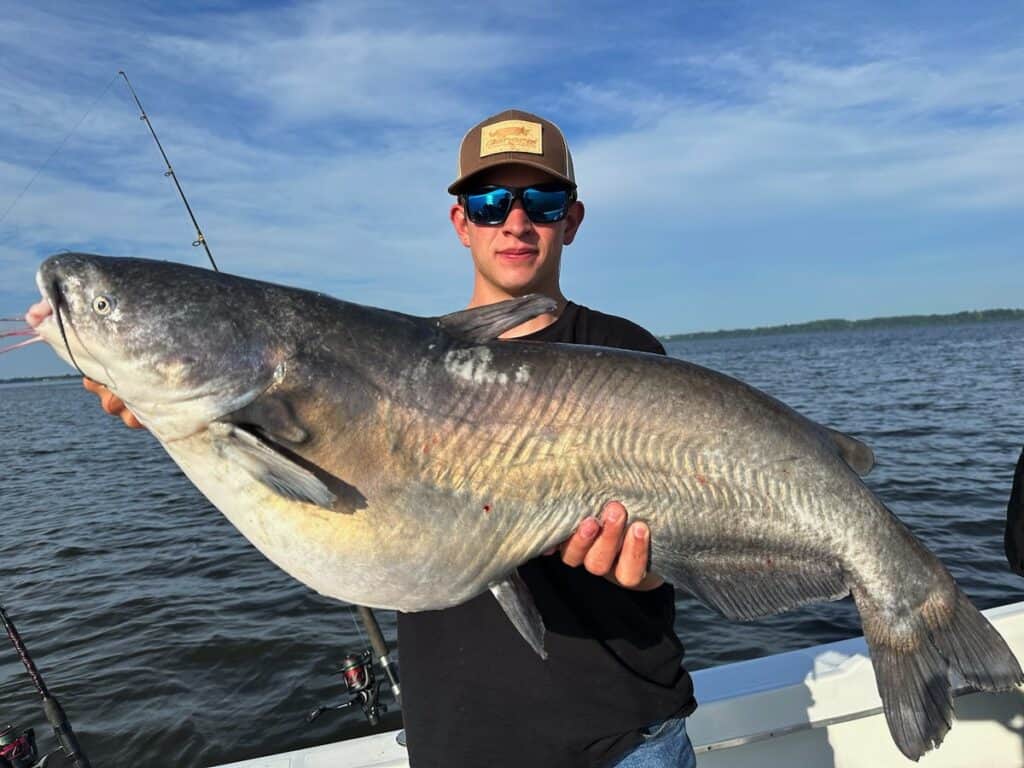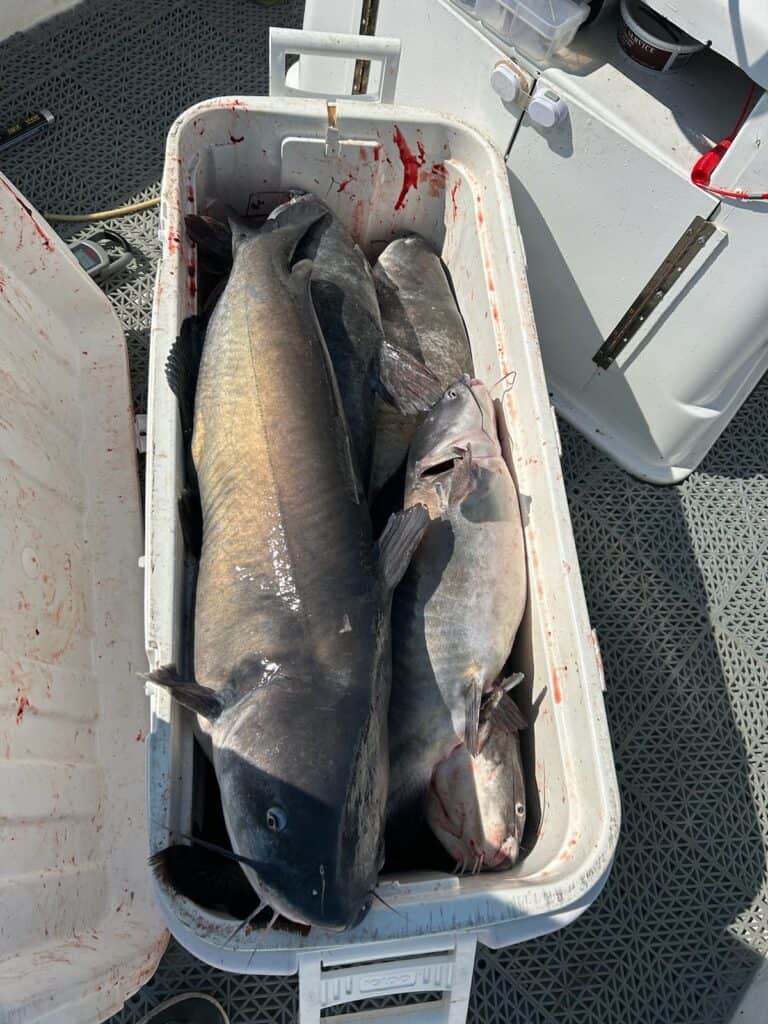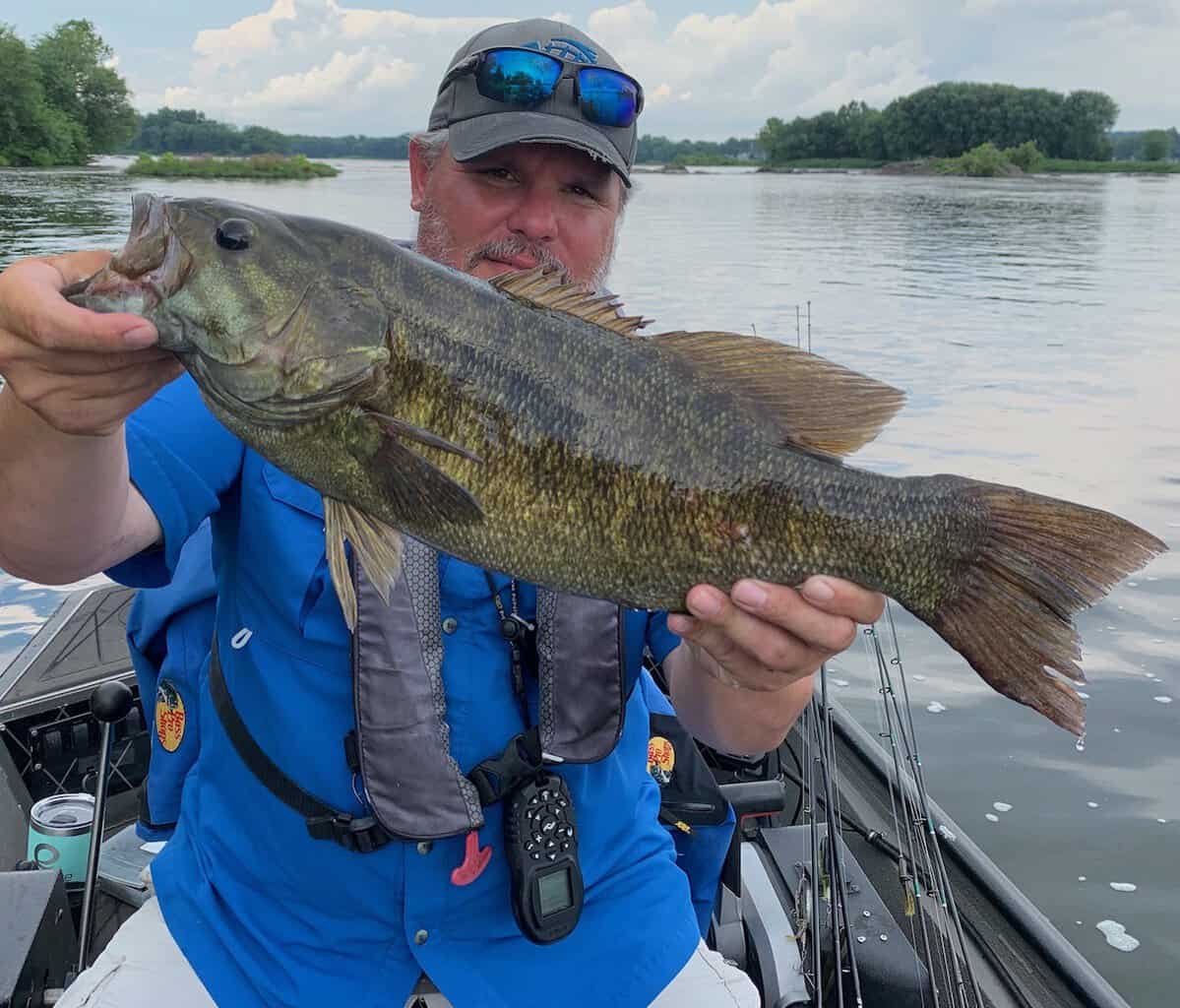A legendary smallmouth bass river and a rich multispecies fishery, the Susquehanna River is one of the most treasured waterways in the Mid-Atlantic region.
For the most part, the river is broad, rocky and shallow (“a mile wide and a foot deep,” in the words of early settlers) with an abundance of islands, pools, rocky outcroppings and ledges that support not only smallmouth bass but also walleye, channel catfish and a host of other species.
The longest river in the Eastern United States, the Susquehanna River traverses 444 miles from Otsego Lake in New York to the Chesapeake Bay in Maryland. The bulk of the river flows southward through Pennsylvania.
It’s a monumental amount of water. However, we’ll break the river down into sections to help you get your bearings.
The 181-mile section of the Susquehanna River from the New York/Pennsylvania state line to Sunbury, PA, is widely referred to as the North Branch Susquehanna. It’s also referred to as the Main Branch by some.
In New York, neither designation is often used, but for the sake of clarity, this entire section will be called the North Branch throughout this article.
The North Branch merges with the West Branch Susquehanna in Sunbury to form the main stem of the river. The section from here down to Harrisburg is considered the Middle Susquehanna. The Lower Susquehanna is from Harrisburg down through the Maryland state line to the Chesapeake Bay.
Susquehanna River Smallmouth Fishing
Long touted as one of America’s best smallmouth rivers, the Susquehanna remains a bass powerhouse despite some ups and downs in recent times. It’s not unusual to catch 50 or more bronzebacks averaging 12 to 16 inches in a day, and bass over 20 inches and 4 pounds are not uncommon.
Smallmouth Bass Timing & Tactics
Smallmouths inhabit areas throughout the Susquehanna River, but the best tactics and areas to fish vary with the seasons.
Spring
In early spring, as the ice breaks up, smallmouths will still be in their wintering holes. That is to say, they’ll be in the deepest available pools. “Deep” is a relative term, of course, and it usually means 8 to 10 feet deep in the North Branch or 12 to 15 feet in the Middle Susquehanna.
As waters warm into the 40s, bass will perk up a bit. Big bass are hungry but lethargic at this time, and the best way to tempt them is by slowly working a dark, natural-colored tube or hair jig.
Only as water temps rise over 45 degrees will smallmouths begin to chase active baits.
Anglers tempt a lot of chunky pre-spawn smallmouths with spinnerbaits, which are effective at catching their attention in the often-murky flows of spring. White tends to be the best color.
Targeting current breaks like bridge piers, pilings, rocky outcroppings, and islands is crucial in spring, especially those structures directly upstream of a deep wintering pool.
Summer
Susquehanna smallies spawn between late May and early June. Post-spawn females typically take a few days’ rest following the ordeal, but post-spawn patterns take shape in mid-June, beginning a stretch of great fishing that typically carries through well into summer.
Post-spawn smallmouths are aggressive and prone to reaction strikes, so you’ll want to hit the banks hard if you’re fishing the Susquehanna in June. Tight-wiggling crankbaits and flashy spinnerbaits are among the best lures for Susquehanna River smallmouth bass at this time.
Toward the end of June, smallmouths establish stable summer patterns, feeding actively and usually relating to ambush points. Upper ends of pools, rocks, pilings and shoreline cover are all key locales.
Topwater poppers and Tiny Torpedoes are often excellent early in the morning and late in the evening when smallmouths hunt near shore.
On hot summer days, smallmouths retreat to shady spots and deep pools and will snatch a tube jig or Senko that drifts into their line of sight.
Fall
In September, the Susquehanna’s water level is usually at its annual low point, shallow enough that many areas of the river can be easily waded across. As temperatures start to dip and rains arrive, smallmouths sense the coming winter and eat accordingly.
There are days in fall when it seems like anything you throw can get a bite—stickbaits, soft jerkbaits, swimbaits, you name it. This is the season when 50-fish days are most likely to happen.
As the river continues to cool and smallmouths become less energetic, consider switching back to a staple spring tactic: dragging a hair jig slowly along the bottom of deeper pools. Deep pockets with some rocks offer smallmouths a reprieve from the current.
Winter
Winter is the toughest time to target smallmouths in the Susquehanna River, and relatively few anglers go after bass this time of year. There may be a final flurry of fall activity in December, but once the new year rolls along, things get tough.
Parts of the river are often iced over in January and February. But smallmouths continue to feed. In areas that remain clear of ice, catching winter smallmouths is not impossible, just difficult.
In winter, the best bet is to target deep wintering holes with jigs and tubes. Smallmouths stick close to the bottom when it’s cold, and crayfish are their main winter food source. Work slowly, and do your best to maintain contact with your lure, which can be a tall order when the water is high.
Where to Fish for Smallmouths
It’s nearly impossible to pinpoint the best individual fishing spots on the Susquehanna River, in part because of the sheer size of the waterway. Also, the configuration of the underwater habitat is prone to change from one year to the next.
Many anglers regard the North Branch Susquehanna as the best section for smallmouth bass fishing. Starting at the New York state line, this section flows through Pennsylvania’s Bradford, Wyoming, Luzerne, Columbia, and Northumberland counties.
The North Branch in Pennsylvania is generally easy to bank fish and wade in summer, and Fish & Boat Commission Biologists’ Reports indicate a population of about 950 smallmouths in every mile of river.
Key areas in the North Branch include places where the river splits around islands (it does so numerous times in Wyoming and Luzerne counties) along with narrows, bridge piers, and mouths of tributaries, including the Chemung River and Lackawanna River.
Farther down, the Middle Susquehanna from Sunbury to Harrisburg is also a great stretch for smallmouths. Here the river broadens significantly but mostly remains shallow, frequently forming braided channels around a multitude of rocky islands and outcroppings.
Status of the Smallmouth Fishery
Smallmouth bass populations suffered a well-documented crash in 2005, the effects of which were most keenly felt in the main stem of the river from Sunbury through Harrisburg—historically one of the best sections for bass fishing.
Bass died off in droves, and surviving fish often displayed skin lesions, sores and mysterious black splotches. The culprit was determined to be a deadly cocktail of agricultural runoff and industrial pollution, exacerbated by unusually high water temperatures.
Fortunately, swift cleanup efforts began, and since 2016 or so, smallmouth numbers have been at or near historic levels. A 2022 Fish & Boat Commission survey documented solid numbers and strong back-to-back year classes that should ensure good fishing in years to come.
The Susquehanna today could best be described as a river in recovery. Trophy smallmouths in the middle and lower Susquehanna are less common than they were in the ’90s, but numbers are up, and the north branch—largely spared from the devastation of 2005—is as good as ever.
Catch More Smallmouth Bass
You’re into catching smallies. The following articles will help you catch more.
Best Smallmouth Bass Fishing in Pennsylvania
Best Smallmouth Bass Fishing in New York
Check out our complete guide to simple bass fishing tactics for more smallmouth lure and technique ideas.
Other Fish Species
Although smallmouth bass are the superstar game fish of the Susquehanna River, they’re only part of the story. This river supports a diverse fishery, including world-class fishing for several additional species.
Walleye Fishing
Every section of the Susquehanna has walleye potential, but the North Branch has been cited as one of the best walleye rivers in Pennsylvania, if not the best. Though not necessarily a trophy walleye fishery, the North Branch Susquehanna routinely puts up impressive numbers.
Pennsylvania’s walleye season is closed from March 15th through the first Saturday in May, and some of the best fishing on the North Branch takes place in winter and early spring before the fishery shuts down to protect walleye during the spawn.
Walleye bunch up in slack water areas in winter, especially deep pools below a current break. Compared to bass, walleye are much more active this time of year, and some of the biggest ‘eyes are caught in February, many of them weighing 7 or 8 pounds.
Worm harnesses baited with a fat nightcrawler are the way to go in cold waters.
The section of the North Branch from Tunkhannock downriver to Ransom has some of the best walleye fishing. You’ll find multiple excellent boat launch and shore access sites in this reach.
The weeks following the season re-opener in May also provide some great walleye fishing opportunities, especially for anglers casting stickbaits along rocky banks and the heads of pools from dusk until after dark.
From May into June, the Middle and Lower Susquehanna River also offers some great walleye fishing.
A series of power dams regulate the flow in this section.
Walleye reliably move into the tailwaters below dams in York Haven, Safe Harbor and Holtwood to feed in the evening.
Anglers fishing these spots catch plenty of healthy 15- to 20-inch fish using jigs tipped with live minnows. This is a consistent spring pattern that repeats itself in fall.
Not to be forgotten about, New York’s portion of the Susquehanna River also provides a quality spring and fall walleye bite. Try the public access sites in Windsor, Nineveh and Afton.
Catch More Walleye
Find the Best Walleye Fishing in Pennsylvania
Find the Best Walleye Fishing in New York
Find more lure, bait and technique suggestions in our easy guide to walleye fishing.
Catfish Fishing

These days, anglers fish the Susquehanna River for three major catfish species.
Channel Catfish
Channel catfish are abundant throughout the Susquehanna River. Biting readily on a wide variety of smelly, natural baits, channel catfish favor deep pools, though they often leave these daytime haunts to prowl shallow flats at night.
Average Susquehanna River channel cats weigh between 4 and 10 pounds, and you can expect to catch them in practically any pool of the river. They’re especially abundant below the dams that regulate the main river as well as deeper portions of the North Branch.
The best catfish bite usually takes place during the dog days of summer, a season when fishing for most other species slows down. The Dauphin Narrows area, just above Harrisburg at Marysville, is among the best channel cat spots.
Although channel catfishing is often best at night, they commonly bite during the day as well, especially when the river is muddy or there’s some cloud cover. Channel cats often group together, so a pool that produces one catfish is likely to yield more.
Flathead Catfish
In recent years, anglers have had another species to target on the Susquehanna River: flathead catfish. Though not native to the river, they’ve exploded in numbers and are capable of exceeding 50 pounds.
Their impressive size has earned them some real popularity among Pennsylvania and Maryland anglers. More secretive and solitary than channel catfish, flatheads are almost always caught at night when they emerge from the thick, snaggy cover they prefer during daylight hours.
You’ll find the best flathead fishing in the lower Susquehanna, where anglers have reeled in state records for both Maryland and Pennsylvania in recent years. But flatheads have also been found in the North Branch as far upriver as Bradford County.
Live bluegill, small carp or other baitfish fished near the bottom are the baits of choice. The upper ends of pools are key areas, and in the lower Susquehanna, big flatheads often lurk in the slack water just outside the outflows from dams, including Conowingo Dam, one of Maryland’s best catfish holes.
Blue Catfish

Another potentially massive species, blue catfish are most common in the lowest section of the river, especially in the roughly five-mile section in Maryland below the Conowingo Dam down to about Lapidum (a couple of miles above the I-95 bridge).
Blue cats will get out of the swifter current by stationing behind structures, including the many islands in this section.
You also are likely to find blues near tributary creek mouths, such as Octoraro Creek below the dam on the east bank and Deer Creek a couple of miles downriver on the west side.
Cut-baits are a favorite choice to attract big blue catfish. You can catch your own sunfish or gizzard shad for bait, as the rules allow, or simply buy fresh fish from the market.
This lower river section also has the previously mentioned channel and flathead catfish, so catching a mixed bag of whiskered fish is a possibility.
Catch More Catfish
Check out these great resources:
Musky Fishing
The Susquehanna River provides a very respectable muskellunge fishery, arguably the best place to catch muskies in Eastern Pennsylvania. This is especially true of the North Branch Susquehanna.
Muskellunge were once stocked in the river. But after several years of muskellunge population surveys along the North Branch from Great Bend to Northumberland, officials determined that wild muskies are reproducing so well here that stocking is no longer needed.
Muskellunge inhabit the entire North Branch, including areas well up into New York. Ample shallow weed beds provide ideal nursery habitat for young muskies, and the river’s deep pools offer plenty of places for adult muskies to hunt.
Many anglers target these fish in summer when muskellunge are highly active and willing to expend energy to chase down a large crankbait or spinner, which are favorite Susquehanna River musky lures.
Ambush predators, muskellunge commonly lie in wait among downed tree limbs and beneath undercut banks in deep pools.
The North Branch Susquehanna offers great muskellunge fishing in fall, too. However, the cooler water necessitates a slower approach, like a big bucktail jig or live sucker.
As a general rule, muskellunge inhabit the deepest pools they can find in the North Branch. This habitat preference is also true of the West Branch Susquehanna, which also holds a solid muskie population. Both stretches of river harbor muskies over 40 inches.
Catch More Muskies
West Branch Susquehanna River Trout Fishing
Trout aren’t really part of the equation along most of the Susquehanna River. But the West Branch Susquehanna actually has some unique trout fishing opportunities.
The fishing here has been getting better and better in recent years.
Authorities have made major efforts to rehabilitate the once-polluted West Branch, including dam removal and cleaning up acidic runoff from long-abandoned mining operations.
These efforts have begun to really pay off. Wild brown and brook trout, long absent from the river, are making a comeback.
Brown trout are the most common, and there are some good-sized fish lurking in the West Branch Susquehanna River’s pools and pocket water.
Fly fishing in the river (and the many smaller streams that feed it) is better than it’s been in decades.
The best trout fishing is in the upper part of the West Branch, above Curwensville Reservoir. Above the reservoir, the river is free-flowing through Cambria and Clearfield counties.
This area is reminiscent of a western trout stream, meandering through wooded hills as it tumbles over a rocky bottom that helps keep the water oxygenated. Nymphing is a popular tactic for the increasingly abundant brown trout, which can reach 20 inches.
Some of the best areas are around the mouths of tributaries like Chest Creek, Cherry Run, Bell Run, Shryock Run and Boiling Springs Run.
The Fish & Boat Commission stocks these and other streams with various combinations of brook, brown and rainbow trout.
Catch More Trout
Trout anglers will be interested in the following:
Largemouth Bass Fishing
Easily overshadowed by the Susquehanna River’s world-class smallmouth bass fishery, largemouth bass are often overlooked. But there’s a sleeper largemouth population here, especially in the Lower Susquehanna River from Southern Pennsylvania into Maryland.
Largemouth bass thrive in the power dam pools of the Lower Susquehanna River, albeit at a lower population density than smallmouths.
The areas immediately above each dam provide almost lake-like conditions, with gentle current and ample weed growth.
The section above Conowingo Dam—also known as Conowingo Reservoir—harbors a substantial population of largemouths, with many fish weighing 3 or 4 pounds.
But the best largemouth fishing is in the tidal portion of the Susquehanna in Maryland, which runs from Conowingo Dam to the river’s confluence with the Chesapeake Bay.
Try a curlytail grub or drop-shot-rigged plastic worm along the river ledges in spring.
There’s also good largemouth action in late spring and summer along rip-rap banks, fallen timber, weedy flats, around Garrett Island, and along the I-95 and U.S. Route 40 bridges.
Shallow beds of milfoil, hydrilla and eelgrass are prime areas for spawning largemouths in May.
Catch More Largemouth Bass
Next-level info for busting bucketmouths:
Susquehanna River Striper Fishing
Striped bass enter the Chesapeake Bay in vast numbers every spring to spawn, and a significant portion of those fish head toward the Susquehanna River, the Chesapeake’s northernmost major tributary.
Dams on the Lower Susquehanna prevent most striped bass from getting very far, though occasional stripers are caught as far upriver as Harrisburg. That being said, the only significant striper opportunities in the river are downstream from Conowingo Dam.
Ground zero of this fishery is known as Susquehanna Flats, a vast area of shallow grass beds near the mouth of the river that spans 9,000 acres.
During March and April, when fishing for stripers on the flats is catch–and-release only, anglers battle some of the biggest fish of the year on their way into the river to spawn. Many of these monsters weigh 30 to 45 pounds.
Please note that regulations are in flux for the Susquehanna Flats, where at last update, officials were working toward ending a short spring keeper season to further protect spawning stripers.
In summer, schools of smaller stripers regularly bust schools of baitfish over the Susquehanna flats. Anglers catch lots of healthy 5- to 10-pound stripers on jerkbaits and topwater poppers, often along with a few of the resident largemouths that also inhabit the area.
Catch More Stripers
Planning Your Trip
The Susquehanna River generally fishes best from May through October, when temperatures are agreeable and water levels are usually low enough to allow safe wading and navigation. Late fall and winter also offer some unique opportunities.
The river is, for the most part, shallow and rocky, which means that boaters should use caution. In general, shallow drafting craft like jet boats are the best bets, and canoes and kayaks can be ideal.
Some areas are more easily accessed using traditional fishing boats with outboard motors. For example, parts of the North Branch from Tunkhannock to Shickshinny have deeper, more easily navigable pools, as do many areas of the Middle and Lower river below Harrisburg.
Getting to the Susquehanna River
The Susquehanna River is within two hours’ drive of just about anywhere in Eastern Pennsylvania, including Scranton, Allentown, Lancaster and Philadelphia. Several major population centers are directly on the river, the largest of which are Binghamton, NY, and Harrisburg, PA.
US-11 runs roughly parallel to a significant stretch of the North Branch in Pennsylvania. US-15 does much the same along the West Branch and main stem of the Susquehanna.
Bank & Boat Access
Ample access to the Susquehanna River is available in each of the three states through which the river flows. Access is so abundant that a complete listing of boat ramps and bank fishing sites is virtually impossible.
Anglers can fish New York’s portion of the river through around 25 public access sites throughout Otsego, Chenango, Broome and Tioga counties. This brochure published by the New York Department of Environmental Conservation is a good guide for this part of the river.
Considerably more options are available in Pennsylvania. The North Branch Susquehanna River stretches 181 miles from the New York state line to Sunbury, and is accessible through dozens of parks and state boat ramps.
Riverside Park in Tunkhannock, Nesbit Park in Kingston and Test Track Park in Berwick are among many great options on the North Branch.
Shikellamy State Park offers boat launch facilities and bank fishing access at the confluence of the North Branch and West Branch Susquehanna River, where they meet to form the river’s main stem. Susquehanna State Park is a popular spot farther up the West Branch in Williamsport.
The Middle Susquehanna River from Sunbury to Harrisburg includes more than a dozen boat launch sites, including state ramps at Sunbury, Hoover’s Island, Mahantango, Liverpool and Fort Hunter.
Bank fishing access is availalbe at each of the aforementioned sites.
City Island is a popular place to launch in the city of Harrisburg, and the Capital Area Greenbelt provides access to several miles of urban river frontage for bank fishing.
Continuing southward to the Lower Susquehanna River, numerous access points are available, including the Falmouth Access, Wrightsville Riverfront Park and Pequea Access. Anglers can also fish at each of the dams in this section.
Down in the Maryland portion of the Lower Susquehanna, there is excellent access at Conowingo Fisherman’s Park, right below the Conowingo Dam. Nearby Susquehanna State Park is another great choice for fishing, boating and camping.
Know Before You Go
Because portions of the Susquehanna River flow through three states, fishing seasons, limits, and other regulations vary. Be sure to acquaint yourself with the current rules in the appropriate state.
The entire Pennsylvania portion of the Susquehanna River system is a network of state water trails popular for paddling as well as fishing. The Susquehanna Greenway Partnership is an excellent resource for finding river access and planning trips along various river sections.


